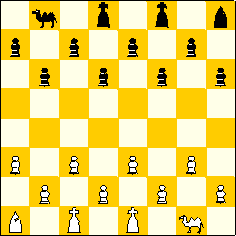Cheskers
There are several games, that can be seen as a cross-over between chess and checkers. This game, invented in 1948 by Solomon W. Golomb, is one of the most well known of these.
Rules
The game is played on the black squares of the board only, starting with the following opening setup:
 White
White
Kings c1, e1; Bishop a1; Camel g1; pawns a3, b2, c3, d2, e3, f2, g3,
h2.
Black
Kings d8, f8, Bishop h8; Camel b8; pawns a7, b6, c7, d6, e7, f6, g7,
h6.
Pawns move as pieces in checkers: they move, without taking, one square diagonally forward, but take by jumping two squares diagonally forward over an enemy piece to an empty square, thereby removing the enemy piece. When a pawn can take, it is obligatory to make a capture (either with a pawn or with an other piece; when there is a choice, the player can choose with which type of piece he takes.) Also, as in draughts and checkers, a pawn can (and when possible must) take more pieces in one turn: when after a first taking of an opponent piece, the pawn can make another jump over an enemy piece, the move continues with such a taking move, until no such type of move is possible. When there is a choice between a move where a single piece or where multiple pieces are taken, the player must make a move with multiple captures. Reaching the last row of the board always ends a pawns move, and the pawn can promote to king, bishop or camel.
A king moves as a promoted checkers piece: this is the same type of move as a pawn in this game, but now the king can move and take also diagonally backwards. When a player can capture with a king, a capturing move is also obligatory.
The bishop moves and takes exactly as in normal chess. The camel has a kind of extended knights move: it goes one diagonal and two straight. With this move, he can jump over other pieces, (like a knight jumps), but the camel takes by moving to the square on which the enemy piece is located. When a player can only capture with a bishop or a camel, it is not obligatory to capture.
The player that captures all opposing kings wins the game. Also, a player that is stalemated (cannot move) loses the game. Black starts.
Sources
This information is mainly based on the description in Pritchard's Encyclopedia of Chess Variants.
Written by Hans Bodlaender
WWW page created: 1995 or 1996. Last modified: May 1, 2013.